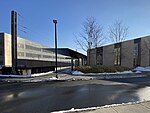Institute for Advanced Study
The Institute for Advanced Study (IAS) is an independent center for theoretical research and intellectual inquiry located in Princeton, New Jersey. It has served as the academic home of internationally preeminent scholars, including Albert Einstein, J. Robert Oppenheimer, Hermann Weyl, John von Neumann, and Kurt Gödel, many of whom had emigrated from Europe to the United States. It was founded in 1930 by American educator Abraham Flexner, together with philanthropists Louis Bamberger and Caroline Bamberger Fuld. Despite collaborative ties and neighboring geographic location, the institute, being independent, has "no formal links" with Princeton University. The institute does not charge tuition or fees.Flexner's guiding principle in founding the institute was the pursuit of knowledge for its own sake. The faculty have no classes to teach. There are no degree programs or experimental facilities at the institute. Research is never contracted or directed. It is left to each individual researcher to pursue their own goals. Established during the rise of fascism in Europe, the institute played a key role in the transfer of intellectual capital from Europe to America. It quickly earned its reputation as the pinnacle of academic and scientific life—a reputation it has retained.The institute consists of four schools: Historical Studies, Mathematics, Natural Sciences, and Social Sciences. The institute also has a program in Systems Biology. It is supported entirely by endowments, grants, and gifts. It is one of eight American mathematics institutes funded by the National Science Foundation. It is the model for all ten members of the consortium Some Institutes for Advanced Study.
Excerpt from the Wikipedia article Institute for Advanced Study (License: CC BY-SA 3.0, Authors).Institute for Advanced Study
Einstein Drive,
Geographical coordinates (GPS) Address Website External links Nearby Places Show on map
Geographical coordinates (GPS)
| Latitude | Longitude |
|---|---|
| N 40.331666666667 ° | E -74.667777777778 ° |
Address
Institute for Advanced Study
Einstein Drive
08544
New Jersey, United States
Open on Google Maps










